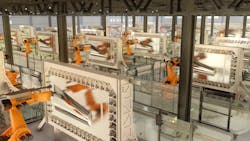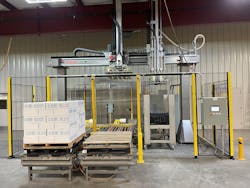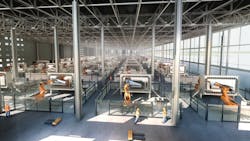Robot integration in manufacturing cells requires proper planning
Pre-engineered robotic cells or systems have been around for as long as robots themselves. Many savvy integrators in the early days of industrial robotics recognized the benefit of using one system design as a building block for future systems. Thus, the concept of pre-engineered systems was born.
These systems are based on a previous existing design and modified for the current system specification. With the increase in the number of these designs, systems that are pre-engineered, pre-assembled and shipped ready-to-work are available for many applications.
One example would include welding cells that are based on part size or weight or type of positioner or production capacity. They can be built on a common base with programs already loaded, employing menus for the customer to quickly generate the required motion programs. Installation and setup consists of placing it on the floor, anchoring it and connecting power. These systems are mature products for a variety of manufacturers, so selecting one requires referencing the manufacturer’s specifications to match your requirements.
Like the welding-cell concept, there are a variety of pre-engineered machine-tending and palletizing cells available. Machine-tending cells can be specific to production machines such as lathes, milling machines, die casting or plastic injection molding. These versions of pre-engineered systems are also designed for quick setup and installation with predefined I/O for easy machine interconnect and communication and are offered within standard sizes based on the size of the customer’s machine.
With the rapid expansion of industries embracing robotic-based automation, pre-engineered systems are beginning to appear in more unique applications than the traditional machine-tending, welding and material-handling cells. We are seeing pre-engineered systems developed now for nondestructive testing (NDT), part inspection, many assembly processes, parts placement for modular construction, wind-turbine-blade assembly and inspection and transformer core stacking (Figure 2).
Many pre-engineered systems are built on a common base, meaning mechanical installation is faster and program startup is completed prior to shipment, so there are no points requiring touchup due to installation tolerances. Likewise, system safety is set and standardized to the most recent standards, whether it is a traditional or cobot-based system. So, if a factory-acceptance test (FAT) is run before shipment to the final installation site, then everything remains intact for the plant startup.
Without the need for design time and program debugging in the build process, pre-engineered systems should have shorter lead times, faster installations and quicker startups. Thus, pre-engineered systems reduce the risk in automating processes over traditional custom systems or systems specifically built to unique specifications.
Factories will want to see benefits like these from pre-engineered systems when evaluating their automation needs. These are entry-level systems to starting an automation journey.
Making the system available as a subscription service, in which the factory pays by the hours instead of managing a capital investment, can be an attractive incentive to manufacturing facilities. Offering pre-engineered systems often involves modifications that simplify the system-development process, as a modification can become the basis for a new pre-engineered option in the ever-growing list of applications for them.
The process of integration
Selecting or specifying a pre-engineered system requires a process similar to the process of originally creating these systems or developing custom solutions. The first step is to recognize the need and to evaluate if robotics is an applicable solution.
Then identify your system specification by defining what the system must do. Look at your existing process; determine reach, payload and speeds required; decide how much operator involvement is required; look at any part quality concerns; determine how this system will interface with your production system both upstream and downstream; and evaluate your staff’s technical capability to support this system after implementation.
With this homework completed, you will determine if robots are a viable solution for your process. After this, evaluate if any pre-engineered systems exist that fit your need. If not, are there some that are close and could these be a candidate for a slight modification to accomplish your goal? If not, you are in the custom system market.
Continuing the process of system development, evaluate your part flow into and out of the system. Parts must be in a repeatable and known position and orientation for the robot to perform the work.
How will the parts be presented to the robot? Will they be presented in an organized fashion and in a repeatable position or random? If they are random, how will they be detected, and how will they be oriented for the robot to process them?
Fix any part quality issues before the robot processes it, or you risk making bad parts out of bad parts. Provide a detection system for these bad parts, and give the system the ability to make decisions on these. Will they be rejected and go on to the next part, or do you want to stop the line to evaluate the cause of the bad part and make a fix?
Consider how you want the finished parts to exit the system. The benefit to stacking or placing them in a repeatable fashion after processing is that you know where they are without detecting them later for any additional automated processes. If you put them on a conveyor or drop them into a bin you have “let go” of them and must detect and orient them again if you plan to automate any additional downstream processes.
In your factory or plant control system, define any communication required in both directions to maintain a consistent part flow. This means defining communication interfaces with your production system, which leads to I/O hierarchy and standards along with operator interface standardization.
Decide whether the system will auto-start or if it requires operator interface, and, if the system stops, how is your upstream flow affected likewise? If downstream stops, does the automation cycle stop, or can it halt as is and finish your part when it restarts?
Other considerations include site prep for installation and evaluating space requirements. This involves removing existing equipment in the site, supplying proper power, compressed air or other services required by your new system. Along with space requirements, is space available to transport your new system from your loading dock to its final installation site on your floor? And, last, check your floor conditions like thickness and quality of concrete for anchoring along with anchoring any peripheral equipment such as conveyors to provide repeatable parts movement in and out of your new system.
In summary, the many pre-engineered robot-based systems available today offer advantages to the end user and to the integrator, but they also require as detailed of a system-development process as the traditional custom design systems.
Register for the conference at Automate Registration.
About the Author
Bob Rochelle
ANR
Bob Rochelle, principal at ArtsNRobots (ANR), will present "Getting Started With Industrial Robotics" at 10:15 am on May 12 during A3’s Automate 2025 in Detroit. The presentation is designed for an audience just starting their automation journey.
After nearly four decades of work experience at system integrators and robot manufacturers, Rochelle semi-retired in July 2024. Through ANR he continues to work educating manufacturers to embrace automation and robotic technology and improve their operational efficiency and increase their business. Rochelle can be contacted at [email protected].
Other articles by Bob Rochelle include:

Leaders relevant to this article:




